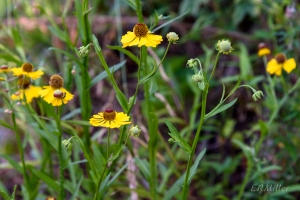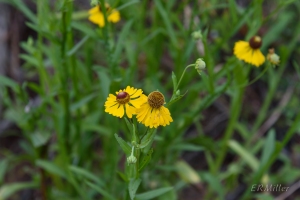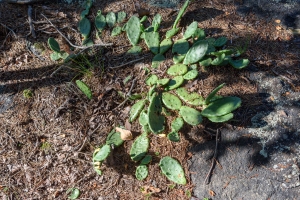Somewhere around the midpoint of the Billy Goat A trail, at about the highest elevation, is an area called Pothole Alley. This exposed bedrock was riverbed back before the Potomac cut the Gorge, and the water-smoothed rocks are full of potholes.

It’s neat to see something like this at the top of cliffs fifty feet above the river, but what’s even neater to a botanerd like me is that the potholes, filled only by rainwater (flooding at this elevation happens every few decades, on average), hold enough water to support obligate wetland plants, like this one.

spatterdock
Nuphar advena
Nymphaeaceae
Also known as cow lily, yellow pond lily, and immigrant pond lily, spatterdock is native to the eastern half of the US, ranging from Maine to Florida, partway into the Great Plains, and north into Ontario. It grows from a rhizome rooted in shallow, quiet water (one to five feet deep), with most of its leaves floating on the water. It can be aggressive in ideal growing conditions.

Although the flower doesn’t fully open, it opens a bit more than this. When I went back to Pothole Alley three days after taking this photo, I found two more potholes with spatterdock in them, but none of the plants were flowering.
If you look closely at this photo, you’ll see what look like three outer petals (with a bit of green on them) overlapping three inner petals. All six of these are actually sepals; the numerous petals are hidden inside. The flattish part in the center is the pistil, which is surrounded by several rings of stamens.
I think I need to go back to Pothole Alley and try to find a more-open flower to photograph.
A note about the terminology
“Emergent aquatic” is a phrase used to describe a plant’s growth habit. Freshwater aquatic plants are often described as
- emergent: rooted under water, with most of stem, leaf, and flower above or on the surface of the water
- submergent: rooted and with most of the plant under the water
- free-floating: non-rooted, growing in and on the water
“Obligate aquatic” is one of the Wetland Indicator Status terms. These phrases describe a species’ likelihood of being found in wetlands:
- obligate wetland: almost always occur in wetlands (greater than 99% probability)
- facultative wetland: usually occur in wetlands (67% to 99% probability), but may occur in non-wetlands (1% to 33% probability)
- facultative: occur in wetlands and non-wetlands (probability 33% to 67% of occurring in both wetlands and uplands)
- facultative upland: usually occur in non-wetlands (67% to 99% probability), but may occur in wetlands (1% to 33% probability)
- obligate upland: almost never occur in wetlands (less than 1% probability)
(sources: Hydrophytic Plant Classifications; USDA PLANTS Database as linked above)















